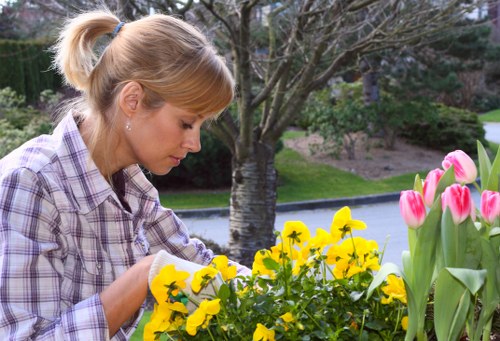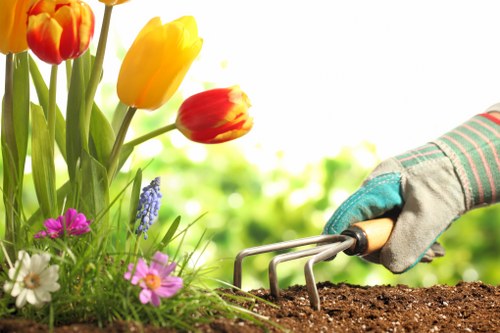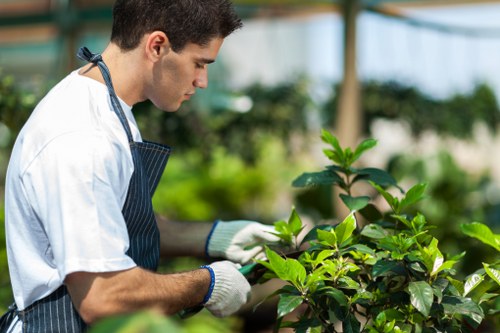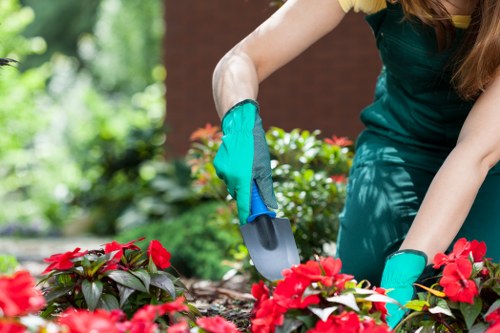Landscape Gardening in Swiss Cottage

Introduction to Landscape Gardening
Landscape gardening in Swiss Cottage is an art that combines aesthetics with functionality, creating outdoor spaces that are both beautiful and practical. Whether you have a sprawling garden or a modest backyard, landscape gardening can transform your outdoor area into a serene retreat.
Swiss Cottage, known for its picturesque streets and charming homes, offers the perfect backdrop for innovative garden designs. The unique climate and soil conditions in this area provide a diverse range of possibilities for garden enthusiasts.
In this article, we'll explore the key elements of landscape gardening in Swiss Cottage, offering tips and ideas to help you create a stunning garden that complements your home and lifestyle.

Planning Your Landscape Garden
Assessing Your Space
Before you begin any garden project, it's essential to assess your available space. Consider the size of your garden, the amount of sunlight it receives, and the type of soil you have. These factors will influence the plant species and garden design you choose.
Swiss Cottage gardens can range from small balconies to large private estates. Understanding the limitations and potential of your space is the first step in creating a successful landscape.
Take measurements and sketch a rough layout of your garden area. This will help you visualize different design options and make informed decisions about plant placement and garden features.
- Measure the dimensions of your garden.
- Note the amount of sunlight in different areas.
- Check soil quality and drainage.

Choosing the Right Plants
Climate Considerations
Swiss Cottage experiences a temperate climate, which means you have a wide variety of plants to choose from. Select plants that thrive in your local conditions to ensure a healthy and vibrant garden.
Consider the seasonal changes and how they will affect your garden. Incorporate a mix of evergreen and deciduous plants to maintain year-round interest.
Some popular choices for Swiss Cottage gardens include lavender, roses, and ornamental grasses, which add texture and color throughout the seasons.
- Research plant hardiness zones.
- Select drought-resistant plants.
- Incorporate native species for easier maintenance.

Design Elements in Landscape Gardening
Hardscaping Features
Incorporating hardscaping elements like pathways, patios, and walls can add structure and functionality to your garden. These features not only enhance the visual appeal but also define different areas within your outdoor space.
Stone, brick, and wood are popular materials for hardscaping in Swiss Cottage gardens. Choose materials that complement the style of your home and garden.
Consider adding a water feature, such as a fountain or pond, to create a focal point and introduce the soothing sound of flowing water.
- Pathways guide movement through the garden.
- Patios provide a space for outdoor seating.
- Walls and fences add privacy and structure.

Maintaining Your Landscape Garden
Regular Care and Upkeep
Maintaining a landscape garden requires regular care to keep plants healthy and the overall garden looking its best. This includes watering, pruning, weeding, and fertilizing.
Implement a maintenance schedule tailored to the needs of your specific plants. Proper maintenance not only enhances the beauty of your garden but also extends the life of your plantings.
In Swiss Cottage, it's important to prepare your garden for seasonal changes. Protect delicate plants during harsh winters and ensure proper irrigation during dry spells.
- Water plants regularly, especially during dry periods.
- Prune shrubs and trees to promote healthy growth.
- Remove weeds to prevent competition for resources.

Enhancing Your Garden with Accessories
Lighting and Decorations
Garden accessories like lighting and decorative elements can enhance the ambiance of your landscape. Outdoor lighting not only adds beauty at night but also improves safety and security.
Choose solar-powered lights for an eco-friendly option, or opt for traditional fixtures for a classic look. Decorative items such as sculptures, birdbaths, and garden furniture add personality and charm to your outdoor space.
Strategically placed lighting can highlight key features of your garden, such as pathways, trees, and water features, creating a magical atmosphere after dark.
- Install pathway lights for safe navigation.
- Use spotlights to highlight focal points.
- Add decorative lanterns for a cozy feel.

Sustainable Landscape Gardening Practices
Eco-Friendly Techniques
Incorporating sustainable practices into your landscape gardening not only benefits the environment but also creates a healthier garden. Use organic fertilizers and pesticides to reduce chemical usage and promote biodiversity.
Implementing rainwater harvesting systems can help conserve water and provide a natural source of irrigation. Additionally, selecting native plants supports local wildlife and reduces the need for excessive watering and maintenance.
Composting kitchen and garden waste enriches your soil naturally, enhancing its fertility and structure without relying on synthetic additives.
- Use mulch to retain soil moisture.
- Plant native species to support local fauna.
- Recycle garden waste through composting.

Seasonal Gardening Tips
Adapting to Seasonal Changes
Swiss Cottage experiences distinct seasons, each bringing its own set of challenges and opportunities for your garden. Adapting your gardening practices to the changing seasons ensures your landscape remains vibrant year-round.
In spring, focus on planting annuals and preparing beds for the growing season. Summer requires diligent watering and pest control, while autumn is the time for harvesting and preparing plants for winter.
Winter maintenance involves protecting sensitive plants and planning for the next year's garden. Understanding the needs of your garden throughout the year enhances its resilience and beauty.
- Spring: Planting and soil preparation.
- Summer: Watering and pest management.
- Autumn: Harvesting and cleanup.

Garden Styles Suitable for Swiss Cottage
Traditional vs. Modern Designs
The architectural style of your home in Swiss Cottage can influence your garden design. Traditional gardens often feature structured layouts, classic plant selections, and elegant hardscaping.
Modern landscape gardens, on the other hand, embrace minimalism, clean lines, and contemporary materials. Both styles offer unique benefits, and the choice depends on your personal preferences and the existing aesthetics of your property.
Hybrid designs that blend traditional and modern elements can create a balanced and harmonious garden, offering the best of both worlds.
- Traditional gardens: Symmetrical layouts, classic plants.
- Modern gardens: Minimalist design, innovative materials.
- Hybrid gardens: Blend of traditional and modern elements.

Expert Tips for a Stunning Landscape Garden
Maximizing Your Garden's Potential
Creating a stunning landscape garden in Swiss Cottage requires careful planning and attention to detail. Here are some expert tips to help you make the most of your garden space:
1. Start with a Plan: Outline your garden layout, including plant placement, hardscaping features, and accessory locations. A well-thought-out plan ensures a cohesive and balanced design.
2. Focus on Focal Points: Highlight key areas of your garden with focal points like a beautiful tree, a water feature, or a unique sculpture. These elements draw the eye and add interest to your landscape.
3. Diversify Plant Selection: Choose a variety of plants with different textures, colors, and heights to create depth and visual interest. Incorporate perennials, annuals, shrubs, and trees for a dynamic garden.
- Plan your garden layout carefully.
- Incorporate focal points for visual interest.
- Diversify plant species for depth.

Budget-Friendly Landscaping Ideas
Creating Beauty Without Breaking the Bank
Landscape gardening in Swiss Cottage doesn't have to be expensive. There are numerous ways to create a beautiful garden on a budget:
Reuse and Repurpose: Use reclaimed materials for garden features like benches, planters, and pathways. Old pallets can be transformed into stylish garden furniture, adding character without the cost.
DIY Projects: Engage in DIY projects such as building raised beds, creating compost bins, or making your own garden decorations. These projects not only save money but also add a personal touch to your garden.
Plant propagation techniques like cuttings and division allow you to multiply your plants without purchasing new ones, reducing your gardening expenses.
- Use reclaimed materials for garden features.
- Engage in DIY garden projects.
- Propagate plants to save on costs.

Incorporating Sustainable Practices
Eco-Conscious Gardening
Sustainable landscape gardening practices contribute to environmental preservation and create a healthier ecosystem in your garden. Here are some ways to make your Swiss Cottage garden more eco-friendly:
Rainwater Harvesting: Collecting rainwater helps conserve water and provides a natural irrigation source for your plants. Install rain barrels or other harvesting systems to make the most of rainfall.
Composting: Composting organic waste enriches your soil and reduces landfill usage. A compost pile or bin can provide nutrient-rich compost for your garden, enhancing plant growth.
Native Plants: Planting native species supports local wildlife and requires less maintenance, as these plants are adapted to the local climate and soil conditions.
- Install rainwater harvesting systems.
- Start composting your garden and kitchen waste.
- Choose native plants to support biodiversity.

Creating a Wildlife-Friendly Garden
Attracting Beneficial Fauna
A wildlife-friendly garden not only enhances the beauty of your landscape but also supports local ecosystems. By creating habitats for beneficial fauna, you contribute to biodiversity and natural pest control.
In Swiss Cottage, you can attract a variety of wildlife by providing food, water, and shelter. Planting nectar-rich flowers attracts pollinators like bees and butterflies, while birdhouses and bat boxes offer nesting sites.
Incorporate water features like birdbaths or small ponds to provide drinking and bathing spots for wildlife. Additionally, leaving some areas of your garden wild with native plants creates natural habitats for various species.
- Plant pollinator-friendly flowers.
- Install birdhouses and bat boxes.
- Provide water sources for wildlife.

Advanced Landscaping Techniques
Taking Your Garden to the Next Level
For those looking to elevate their landscape garden, advanced techniques can add sophistication and uniqueness to your space:
Vertical Gardening: Maximize space by growing plants vertically using trellises, green walls, or hanging planters. This technique is especially useful for small gardens, allowing you to incorporate a variety of plants without taking up much ground space.
Terracing: Create terraces on sloped areas to prevent soil erosion and provide level planting areas. Terraces can add structure and visual interest to your garden while making it easier to manage different plantings.
Outdoor Structures: Incorporate structures like pergolas, arches, and gazebos to add functionality and aesthetic appeal. These structures provide shade, define spaces, and serve as support for climbing plants.
- Implement vertical gardening solutions.
- Create terraces on sloped areas.
- Add outdoor structures for functionality and beauty.

Personalizing Your Garden Space
Adding Unique Touches
Your landscape garden should reflect your personal style and preferences. Adding unique touches can make your garden feel more inviting and tailored to your tastes:
Artistic Elements: Incorporate sculptures, mosaic paths, or custom-made garden art to add a creative flair. These elements can serve as conversation starters and focal points in your garden.
Color Schemes: Choose a cohesive color palette for your plants and garden elements. Whether you prefer vibrant hues or a more subdued, monochromatic look, a consistent color scheme enhances the overall harmony of your garden.
Personal Spaces: Create dedicated areas for relaxation, dining, or recreation. A comfortable seating area, an outdoor kitchen, or a meditation nook can make your garden a multifunctional space tailored to your lifestyle.
- Add artistic garden sculptures.
- Choose a cohesive color palette.
- Create dedicated personal spaces.

Conclusion: Transform Your Swiss Cottage Garden
Landscape gardening in Swiss Cottage offers endless possibilities to create a beautiful and functional outdoor space. By carefully planning your garden, selecting the right plants, and incorporating various design elements, you can transform your garden into a personal oasis.
Remember to maintain your garden with regular care and consider sustainable practices to ensure its longevity and environmental friendliness. Whether you're a seasoned gardener or a beginner, the principles outlined in this article can help you achieve a stunning landscape garden that enhances your Swiss Cottage home.
Ready to transform your outdoor space? Contact us today to get started on your landscape gardening journey in Swiss Cottage. Our team of experts is here to help you design and maintain the garden of your dreams.

